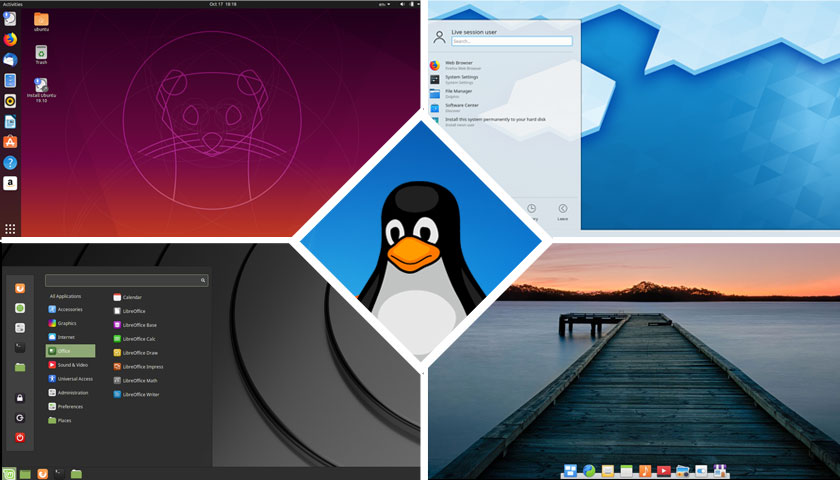There are so many different versions of Linux available, it can be hard to decide which one that’s right for you. So we’ve picked five that you should try first, as it’s likely that at least one of them will fit your Linux needs precisely.
They’re all free of course, so try them all.
Ubuntu

Canonical has the most prevalent Linux distribution available, and Ubuntu’s popularity belies the polish and elegance of their kernel, platform and GUI combination.
Version 16.10 or “Yakkety Yak” was released in October 2016 and the latest version is 17.04 “Zesty Zapus”. It’ll be interesting to see what the next version is called now the whole alphabet is used up.
To create an Ubuntu PC, you’ll need a minimum of a dual-core processor, 2GB of RAM and 25GB of free space. Though, it can launch from a USB drive or even DVD.
Those live trial options make it perfect for anyone wanting to experiment without committing to a hard drive installation.
The inclusion of the Kernel 4.8 has addressed power management issues with Skylake processors, and Ubuntu also bundles the latest Nvidia Pascal GPU drivers.
Unity is the preferred GUI, derived from GNOME, but you can easily install LXDE, MATE or Xfce if you like those instead.
Noted for being very swift and hardware efficient, Ubuntu and Unity delivers a slick application environment that most Windows or Mac users won’t find jarring.
IT professionals might also enjoy it, as it is easy for them to create custom installations from Canonical’s comprehensive software repository.
Ubuntu is best considered to be a Linux jack-of-all-trades, that’s outshone in specific tasks by others.
Linux Mint

Originally based on Kubuntu, and then Ubuntu and Debian, Linux Mint is a remix of the latest Ubuntu code blended with their tools and a selection of optional interfaces.
The current 18.1 “Serena” foundational code is that of Ubuntu 16.04 LTS (Long Term Support), utilising MDM 3.2 display manager and Linux kernel 4.4.
The success of the Mint distro was built on those users who wanted to use Linux without having to understand the vagaries of the command line interface. And, for the most part, Linux Mint lives up to its fire-and-forget reputation.
However, a successful hack of the Mint website has diminished the brand reputation. Because of this event many businesses won’t use it, even if those particular problems have been addressed.
For an existing Windows user, there is plenty to like in Mint. Not least that it provides four different desktop GUIs to choose; Cinnamon, MATE, Xfce and KDE.
Most new users are advised to choose MATE, as it supports the widest range of PC hardware specifications.
As each GUI option is provided on a different ISO, rather than all in a single package.
Once the ISO is burned to a DVD, it can run as ‘Live’ or hard drive installed.
The ease of installation is one of the distros key strengths, as it asks relatively few questions during the process.
The consensus is that Mint is good for gaming and for graphical applications, but a little less wonderful from a security perspective.
openSUSE Tumbleweed

Where other releases focus on sysadmins or home users, openSUSE is designed specifically for makers/developers in the Linux community.
Alongside this OS the openSUSE community also helped build two very powerful developer tools meant to work on it; OBS (open build service) and OpenQA.
While not exclusively the preserve of openSUSE, it’s how this distro works with them and other development tools that attracts those with maker ambitions.
The flipside of any development solution is that openSUSE is conservative about the components that are included, choosing stability over contemporary code every time.
The very highest level of stability comes with openSUSE Leap 42.2, ideal for Enterprise deployments. For developers working with more concurrent Kernel’s openSUSE provides Tumbleweed, a rolling release model that updates continually.
The latest version includes KDE Applications 16.12.0, KDE Frameworks 5.29.0, KDE Plasma 5.8.5 and uses Linux Kernel 4.9.0.
In comparison, openSUSE Leap 42.2 still uses the 4.4 LTS Kernel, Frameworks 5.26, KDE Plasma 5.8.
With the focus being Power Users that need the latest software stacks for their projects and want commonality with openSUSE contributors, this platform’s certainly not for casual users or gamers.
Another OpenSUSE catch is the ISO size, at 4GB this is more than double the size of any other distro mentioned here. And, it doesn’t have a ‘Live’ mode inherently.
Not for a Linux novice, but a powerful option for those who already have Linux experience..
Fedora

Where some distributions offer the highest stability or lightweight installs, Red Hat’s Fedora is designed to offer system admins the very cutting (or bleeding…) edge of Linux software technology.
By default, Fedora 25 Workstation comes with all the DevOps tools pre-loaded in its main repository, support for Docker 1.12, the Node.js Javascript engine, five different Python versions, and the Rust programming language.
Release 25 fixed some nasty kernel issues and also switched Fedora from X Server protocol to Wayland, improving client-side graphics efficiency.
That makes the default GUI, GNOME 3.22 run more smoothly, and Fedora operates with the smoothness that Windows and Mac users expect.
The inclusion of the GNOME upgrade tool also handles the transition to the next release seamlessly, when Fedora moves to version 26 and beyond.
All these changes contribute to making Fedora more friendly to Linux novices than it once was. The Live mode easily converts into a full install, for those with commitment issues.
Where a few releases back this distro wasn’t for the casual user, the latest release is as accessible as Ubuntu or Mint. It comes pre-loaded with swathes of high-quality applications, making this distro is ready to go from the outset.
If any other endorsement were needed; Linus Torvalds uses Fedora.
Remix OS

This is a relatively unknown Linux flavour, but one that many users might want to check out.
Built by the Remix team at Jide, it blends an X86 Linux Kernel and the source code for Android Marshmallow. That fusion has generated a desktop version of Android for the PC that will work on relatively modest hardware.
The Windows based installation tool can write the Remix OS ISO to a DVD or USB key, and the latter allows you to run entirely independently of existing storage.
A full install can live on the same drive as Windows via a boot menu, and there is a corresponding experimental feature that enables you to mount existing file systems and files.
Using Remix OS is a somewhat mercurial experience, as Android apps aren’t designed to work through a windowed GUI. The interface launches them by default as portrait aspect panels that you can then move around and resize as you see fit.
Unfortunately like so many custom Android builds, Remix OS preloads a wide selection of commercial applications you might not want, while ignoring many of Google’s default tools.
Thankfully these excesses can be easily cleared out, and with access to the Google Play Store, all the classic Android tools can be quickly added.
Within the limitations of emulating a tablet that doesn’t have a camera, touchpad, GPS location or motion sensors, Remix OS does a sterling job of bringing Android to the PC.
The modest recommended hardware specs are perfect for those who wish to breathe new life into an old computer, and effectively use it as a tablet with a mouse and keyboard attached.



